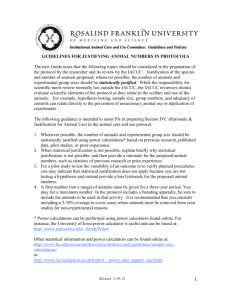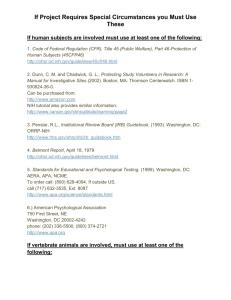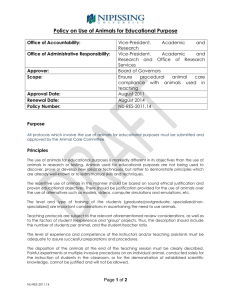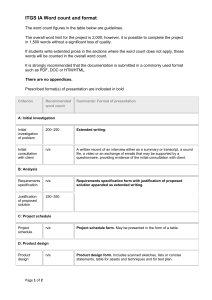Justification of Animal Numbers
advertisement
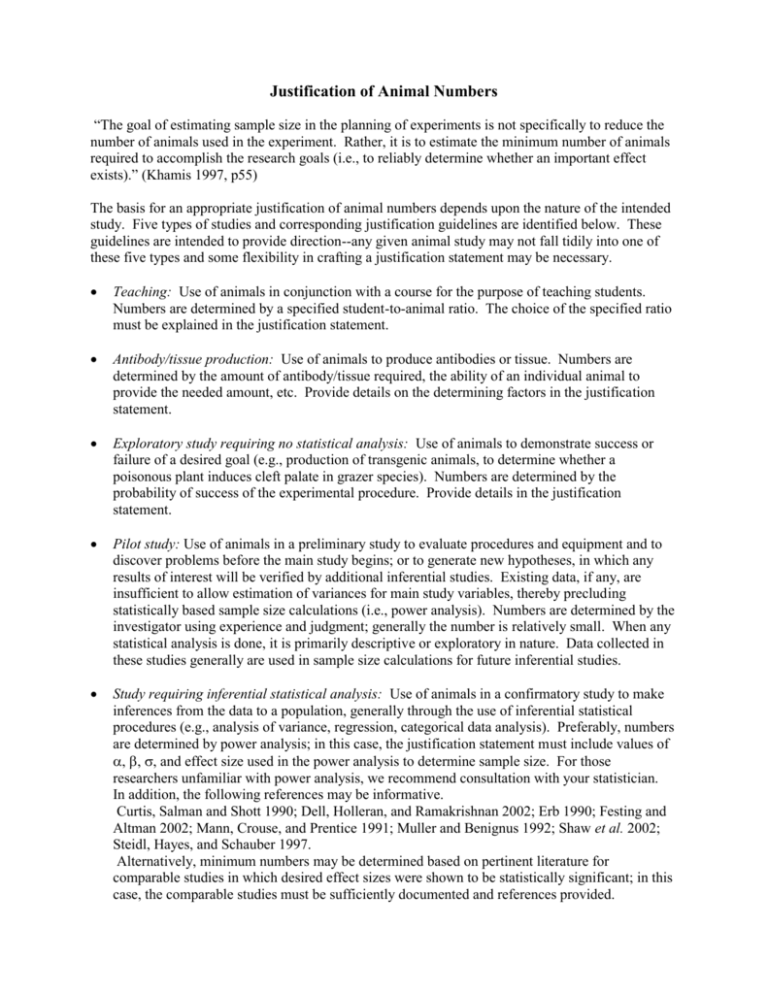
Justification of Animal Numbers “The goal of estimating sample size in the planning of experiments is not specifically to reduce the number of animals used in the experiment. Rather, it is to estimate the minimum number of animals required to accomplish the research goals (i.e., to reliably determine whether an important effect exists).” (Khamis 1997, p55) The basis for an appropriate justification of animal numbers depends upon the nature of the intended study. Five types of studies and corresponding justification guidelines are identified below. These guidelines are intended to provide direction--any given animal study may not fall tidily into one of these five types and some flexibility in crafting a justification statement may be necessary. Teaching: Use of animals in conjunction with a course for the purpose of teaching students. Numbers are determined by a specified student-to-animal ratio. The choice of the specified ratio must be explained in the justification statement. Antibody/tissue production: Use of animals to produce antibodies or tissue. Numbers are determined by the amount of antibody/tissue required, the ability of an individual animal to provide the needed amount, etc. Provide details on the determining factors in the justification statement. Exploratory study requiring no statistical analysis: Use of animals to demonstrate success or failure of a desired goal (e.g., production of transgenic animals, to determine whether a poisonous plant induces cleft palate in grazer species). Numbers are determined by the probability of success of the experimental procedure. Provide details in the justification statement. Pilot study: Use of animals in a preliminary study to evaluate procedures and equipment and to discover problems before the main study begins; or to generate new hypotheses, in which any results of interest will be verified by additional inferential studies. Existing data, if any, are insufficient to allow estimation of variances for main study variables, thereby precluding statistically based sample size calculations (i.e., power analysis). Numbers are determined by the investigator using experience and judgment; generally the number is relatively small. When any statistical analysis is done, it is primarily descriptive or exploratory in nature. Data collected in these studies generally are used in sample size calculations for future inferential studies. Study requiring inferential statistical analysis: Use of animals in a confirmatory study to make inferences from the data to a population, generally through the use of inferential statistical procedures (e.g., analysis of variance, regression, categorical data analysis). Preferably, numbers are determined by power analysis; in this case, the justification statement must include values of , , , and effect size used in the power analysis to determine sample size. For those researchers unfamiliar with power analysis, we recommend consultation with your statistician. In addition, the following references may be informative. Curtis, Salman and Shott 1990; Dell, Holleran, and Ramakrishnan 2002; Erb 1990; Festing and Altman 2002; Mann, Crouse, and Prentice 1991; Muller and Benignus 1992; Shaw et al. 2002; Steidl, Hayes, and Schauber 1997. Alternatively, minimum numbers may be determined based on pertinent literature for comparable studies in which desired effect sizes were shown to be statistically significant; in this case, the comparable studies must be sufficiently documented and references provided. Websites of interest. All links functional as of 12/16/2003: USGS Patuxent Wildlife Research Center. Managers’ Monitoring Manual http://testweb-pwrc.er.usgs.gov/monmanual/ Follow link to references for setting sample size. This site is under construction and may be relocated. Information Resources of Institutional Animal Care and Use Committees 1985-1999. Statistics and Animal Numbers. www.nal.usda.gov/awic/pubs/IACUC/stat.htm University of Nebraska Medical Center IACUC. Justification of the Number of Animals Requested. www.unmc.edu/iacuc/justify.html FRAME Reduction Committee. Bibliography of Training Materials On Experimental Design And Statistical Analysis www.frame.org.uk/reductioncommittee/bibliointro.htm References listed below are available in the IACUC office. A comprehensive set of papers on the design and statistical analysis of animal experiments can be found in the ILAR Journal 43(4) 2002 Experimental Design and Statistics in Biomedical Research: Festing, M. F. W. 2002. Introduction: the design and statistical analysis of animal experiments. ILAR Journal 43(4):191-193. Online at http://dels.nas.edu/ilar/jour_online/43_4/v4304festing_a.asp Howard, B. R. 2002. Control of variability. ILAR Journal 43(4):194-201. Johnson, P. D. and D. G. Besselsen. 2002. Practical aspects of experimental design in animal research. ILAR Journal 43(4):202-206. Dell, R. B., S. Holleran, and R. Ramakrishnan. 2002. Sample size determination. ILAR Journal 43(4):207-213. Gaines Das, R. E. 2002. Role of ancillary variables in the design, analysis, and interpretation of animal experiments. ILAR Journal 43(4):214-222. Shaw, R., M. R. W. Festing, I. Peers, and L. Furlong. 2002. Use of factorial designs to optimize animal experiments and reduce animal use. ILAR Journal 43(4):223-232. Rispin, A., D. Farrar, E. Margosches, K. Gupta, K. Stitzel, G. Carr, M. Greene, W. Meyer, and D. McCall. 2002. Alternative methods for the median lethal dose (LD50) test: the up-and down procedure for acute oral toxicity. ILAR Journal 43(4):233-243. Festing, M. F. W. and D. G. Altman. 2002. Guidelines for the design and statistical analysis of experiments using laboratory animals. ILAR Journal 43(4):244-258. Additional papers of interest: Chamove, A. S. 1996. Reducing animal numbers: sequential sampling. AWIC Newsletter 7(1):3-6. Curtis, C. K., M. D. Salman, and S. Shott. 1990. Power and sample size. Journal of the American Veterinary medical Association 197:838-840. Erb, H. N. 1990. Estimating the optimum number of animals needed in research. ILAR Journal 32(1). Online at http://dels.nas.edu/ilar/jour_online/32_1/V32_1StatisticalApproach.asp Gracely, E. J. 2000. Justification of the number of animals to be used. Ch. 13 (pp. 167-177) in J. Silverman, M. A. Suckow, and S. Murthy, The IACUC Handbook, CRC Press, Boca Raton, FL. Khamis, H. J. 1997. Statistics and the issue of animal numbers in research. Contemporary Topics in Laboratory Animal Science 36(2):54-59. Mann, M. D., D. A. Crouse, and E. D. Prentice. 1991. Appropriate animal numbers in biomedical research in light of animal welfare considerations. Laboratory Animal Science 41(1):6-14. Muller, K. E., and V. A. Benignus. 1992. Increasing scientific power with statistical power. Neurotoxicology and Teratology 14(3):211-219. Peterman, R. M. 1990. Statistical power analysis can improve fisheries research and management. Canadian Journal of Fisheries and Aquatic Science 47:2-15. Steidl, R. J., J. P. Hayes, and E. Schauber. 1997. Statistical power analysis in wildlife research. Journal of Wildlife Management 61(2):270-279. Steidl, R. J., and L. Thomas. 2000. Power analysis and experimental design. In S. M. Scheiner & J. Gurevitch (eds.), Design and Analysis of Ecological Experiments, 2nd ed. Oxford University Press. Thomas, L., and F. Juanes. 1996. The importance of statistical power analysis: an example from Animal Behaviour. Animal Behaviour 52:856-859. Weigler, B. J. 1995. Justifying the number of animals in IACUC proposals. Contemporary Topics in Laboratory Animal Science 34(3):47-50.

